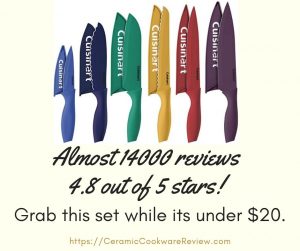If you’ve ever browsed the kitchenware section of a department store, you’re probably familiar with the ceramic knife. You may even already have a set of ceramic knives in your kitchen. Stainless steel knives with ceramic coating, often in eye-catching pastel or neon colors, are becoming increasingly trendy and popular. But what is the big deal about ceramic knives? And what should you be looking for when considering purchasing a good cooking ceramic knife set?
Click the image below to check the price on this set!
Ceramic Knife Basics of a Good Cooking Ceramic Knife Set.
What sets ceramic apart from stainless steel and other metals is what it’s made from. Ceramic knives are made using a material called zirconium oxide, also known as zirconia. It’s extremely lightweight, significantly sharper than steel, and can stay razor sharp for a really, really long time. In fact, ceramic knives can stay sharp for up to 10 times longer than your regular steel blade!
Ceramic is also non-corrosive, non-porous, and doesn’t rust. Because zirconia won’t transfer ions to food, ceramic knives are great for cutting fruits and vegetables. Fruit cut with a ceramic blade will oxidize slower and stay fresher for longer. You’ll also find that if you cut an onion with one, your eyes won’t well up with tears. Some believe this is because of the sharpness of the blade and others say it has to do with zirconia’s chemical composition. Whatever the reason is, it’s certainly a unique perk to going ceramic.
When shopping for a good set of ceramic knives for your kitchen, it’s good to keep in mind what you’ll mostly be using them for. Ceramic knives come in a variety of different shapes and sizes, made for all different purposes:
- Paring knives, perfect for cutting fruits and vegetables
- For the average home cook, a Santoku (Japanese for chef’s)-style knife
- Serrated knives, for cutting bread and softer meats
And the list doesn’t end there- there are plenty of different unique sets to choose from.
The Benefits of Ceramic Knives
When it comes to the “ceramic vs. stainless steel” debate, neither are necessarily better or worse than each other. It all depends on what you’re using them for. Ceramic knives excel with chopping and dicing, but there are some cooking jobs, like deboning or carving meat, that are better left to a less delicate blade. However, ceramic knives do have many benefits that are hard to get from another knife made of steel or metal.
Ceramic knives have a host of great features:
- They’re ultra-lightweight, making them easy to handle for even the most novice cook.
- A ceramic blade won’t need to be sharpened regularly like stainless steel. This makes it a great option for someone who is looking for low-maintenance without sacrificing quality.
- The blades are both razor sharp and extremely thin, allowing you to make extremely precise cuts, slices, and chops.
- Ceramic knives don’t rust or stain with regular use like metal knives do.
How to Care for Ceramic Knives
Ceramic knives are easy to clean and care for. Because zirconia isn’t porous, like steel, you don’t have to worry about the blade retaining bacteria even after being washed. Just gentle hand-washing with soap and water is all your knife really needs. Putting a ceramic knife in the dishwasher runs the risk of it breaking or chipping, which leads into the next tip. While zirconia is technically harder than steel, the blades are still fragile and can chip if you’re too rough with them. Only use ceramic knives on a plastic or wooden cutting board, as stone countertops like granite and marble are too hard for them to be used against.
To store ceramic knives, it’s recommended to have a specific receptacle to keep them in. Ceramic knives placed in a drawer can be accidentally chipped, and they can’t be stuck to traditional magnetic knife holders since they’re not metal. Having protective covers for your knives isn’t a bad idea, either. Many ceramic knife owners find that they protect both the knife and the person using it, given how sharp they are.
Why Ceramic for the Kitchen?
Many of the benefits of ceramic knives apply to ceramic cookware in general, too. Ceramic cookware, just like knives, won’t absorb smells or stains that could otherwise ruin a perfectly fine piece. The material definitely also takes some of the hassle out of washing dishes, being extremely easy to clean and take care of. When you’re using ceramic cookware, you can also rest assured that there’s no aluminum or heavy metals contaminating your food. Ceramic coatings are non-reactive and do not contain the controversial Teflon coating. Being both non-toxic and non-stick at the same time is a great advantage that ceramic cookware has.
If you’re considering investing in some new kitchen gear, ceramic is extremely versatile and there are endless great products utilizing it. Ceramic knives are all the rage with home chefs of all skill levels right now, and for good reason. That isn’t to say you should completely abandon your stainless-steel sets for ceramic. If you’re looking for a shockingly lightweight knife that gives you effortless cuts on foods like meats, fruits, veggies, and cheeses, ceramic might just be the right choice for you. Hope this helps you find a good cooking ceramic knife set.

